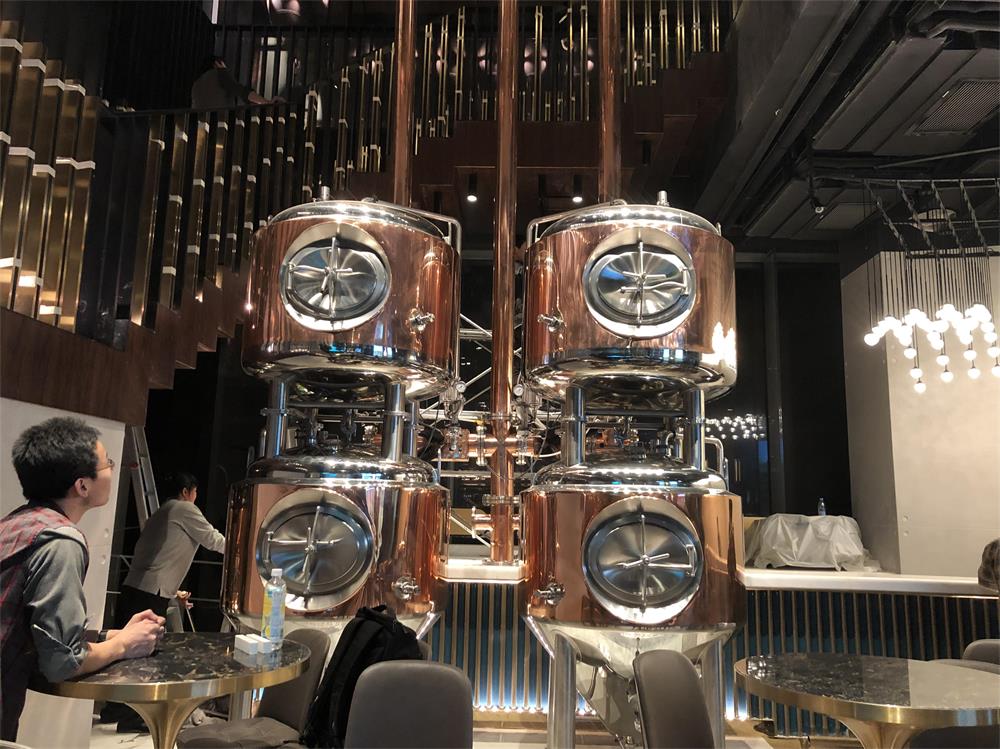Beer Fermentation Equipment
Beer brewing is both an art and a science, with fermentation being one of the most critical stages in the brewing process. The quality of the beer produced depends heavily on the fermentation equipment used. Whether you’re a homebrewer or managing a large-scale brewery, understanding beer fermentation equipment is key to producing high-quality brews. In this article, we will delve into everything you need to know about beer fermentation equipment, from understanding the different types available to how to choose the best one for your needs.
Overview of Beer Fermentation Equipment
Fermentation is the process where yeast converts the sugars in the wort into alcohol and carbon dioxide, creating the beer we all love. The equipment used in this stage is crucial, as it directly affects the quality, flavor, and consistency of the beer. Beer fermentation equipment ranges from simple, homebrew fermenters to complex, industrial-scale systems. This equipment is designed to maintain optimal fermentation conditions, ensuring that the yeast performs efficiently and the beer develops its intended flavor profile.
Guide to Beer Fermentation Equipment
When selecting beer fermentation equipment, it’s essential to consider factors such as capacity, material, design, and customization options. Below, we explore these considerations in more detail.

Types of Beer Fermentation Equipment
Beer fermentation equipment comes in various types, each suited for different brewing scales and needs. Here’s a detailed breakdown:
| Type | Description | Best For | Material |
|---|---|---|---|
| Carboys | Glass or plastic containers commonly used in homebrewing. They are affordable and allow for easy monitoring of fermentation. | Homebrewers | Glass, Plastic |
| Conical Fermenters | These have a cone-shaped bottom that allows yeast and sediment to settle and be easily removed. | Homebrewers, Small Breweries | Stainless Steel, Plastic |
| Unitanks | Advanced fermenters that serve as both fermentation and conditioning vessels. | Large Breweries | Stainless Steel |
| Open Fermenters | Traditional vessels that allow for exposure to the environment, often used in specific beer styles like Belgian ales. | Specialty Breweries | Stainless Steel, Wood |
| Fermentation Tanks | Large tanks designed for high-volume beer production, often with temperature control systems. | Industrial Breweries | Stainless Steel |
Brewing Process and the Role of Fermentation Equipment
The brewing process can be broken down into several key stages, with fermentation being one of the most critical. After mashing, boiling, and cooling the wort, the fermentation stage begins. The wort is transferred to the fermentation equipment, where yeast is added to begin the fermentation process. The choice of fermentation equipment impacts various aspects of this stage, such as temperature control, ease of cleaning, and the ability to manage pressure.
During fermentation, the yeast converts sugars into alcohol and carbon dioxide. The temperature at this stage must be carefully controlled, as it affects the flavor profile of the beer. For example, warmer temperatures may lead to fruity esters, while cooler temperatures produce cleaner, crisper beers. Fermentation equipment that includes temperature control features is, therefore, highly desirable.
Capacity, Space, and Design Considerations
When choosing beer fermentation equipment, the size and design must align with your brewing needs and available space. Below is a table summarizing the key considerations:
| Aspect | Details | Considerations |
|---|---|---|
| Capacity | Equipment ranges from 5-gallon fermenters for homebrewers to 10,000-gallon tanks for industrial breweries. | Match capacity to brewing scale. |
| Space Requirements | Large fermenters may require more space and may need to be installed in a temperature-controlled environment. | Ensure sufficient space for installation and operation. |
| Design and Layout | Vertical and horizontal fermenters are available, with some designed for stackable storage. | Consider the layout of your brewing space. |
| Customization | Many manufacturers offer customization options for features like additional ports, pressure gauges, and more. | Customization can enhance brewing flexibility. |
Suppliers and Price Range for Beer Fermentation Equipment
The market for beer fermentation equipment is diverse, with a wide range of suppliers offering products at different price points. Here’s a breakdown:
| Supplier | Price Range | Key Features | Target Market |
|---|---|---|---|
| SS Brewtech | $200 – $3,000 | Offers a range of homebrew and small brewery fermenters with advanced features. | Homebrewers, Small Breweries |
| Blichmann Engineering | $300 – $5,000 | Known for high-quality conical fermenters with temperature control. | Homebrewers, Small Breweries |
| A.B.E. Beverage Equipment | $10,000 – $100,000+ | Industrial-scale fermenters with full automation options. | Large Breweries |
| Speidel | $150 – $2,500 | Offers plastic and stainless-steel fermenters with easy cleaning features. | Homebrewers, Small Breweries |
| JVNW, Inc. | $50,000 – $200,000+ | Custom-made fermentation tanks for large breweries, focusing on durability and efficiency. | Large Breweries |
Installation, Operation, and Maintenance of Beer Fermentation Equipment
Proper installation, operation, and maintenance are crucial for the longevity and effectiveness of beer fermentation equipment. Below, we break down these aspects:
| Aspect | Details | Tips for Success |
|---|---|---|
| Installation | Equipment should be installed in a clean, temperature-controlled environment, with proper drainage and ventilation. | Hire professionals for large-scale equipment installation. |
| Operation | Operators should be trained in monitoring temperature, pressure, and cleanliness during fermentation. | Regularly check and calibrate control systems. |
| Maintenance | Routine cleaning and sanitization are essential to prevent contamination. Regular inspections help detect wear and tear early. | Use food-grade cleaning agents and keep detailed maintenance records. |
How to Choose a Beer Fermentation Equipment Supplier
Selecting the right supplier for your fermentation equipment is crucial for your brewing success. Here’s how to make the best choice:
| Consideration | Details | Advice |
|---|---|---|
| Reputation | Look for suppliers with positive reviews, long-standing industry experience, and a good track record. | Ask for references from other breweries. |
| Customization Options | Suppliers that offer customization can better meet your specific brewing needs. | Consider future expansion when choosing custom features. |
| Support and Service | Good suppliers offer robust after-sales support, including installation, training, and maintenance services. | Ensure the supplier provides comprehensive support. |
| Price vs. Quality | Balance your budget with the need for high-quality, durable equipment. | Don’t compromise on quality to save costs. |
| Lead Time | Consider the supplier’s ability to deliver equipment within your required timeline. | Plan your purchase ahead to avoid delays in brewing. |
Pros and Cons of Different Beer Fermentation Equipment
Each type of fermentation equipment has its advantages and limitations. Here’s a comparative overview:
| Type | Advantages | Disadvantages |
|---|---|---|
| Carboys | Affordable, easy to use, and transparent for monitoring fermentation. | Fragile (glass), limited capacity, no pressure control. |
| Conical Fermenters | Easy yeast removal, can be pressurized, durable. | Higher cost, takes up more space. |
| Unitanks | Combines fermentation and conditioning, supports pressure fermentation. | Expensive, requires more complex setup. |
| Open Fermenters | Allows unique flavors to develop, traditional method. | Risk of contamination, requires careful monitoring. |
| Fermentation Tanks | High capacity, advanced temperature control, suitable for large-scale production. | Expensive, large space requirements, complex operation. |

FAQs
| Question | Answer |
|---|---|
| What is the best material for fermentation equipment? | Stainless steel is the best due to its durability, ease of cleaning, and resistance to contamination. |
| Can I use plastic fermenters for long-term fermentation? | While plastic fermenters are affordable and lightweight, they are more prone to scratching and may harbor bacteria over time. Stainless steel is preferred for long-term use. |
| How important is temperature control in fermentation equipment? | Temperature control is critical as it directly impacts yeast activity and the flavor profile of the beer. Equipment with built-in temperature control features is ideal. |
| What’s the difference between a conical fermenter and a unitank? | A conical fermenter is primarily used for fermentation, while a unitank can handle both fermentation and conditioning, often with pressure control. |
| How do I sanitize my fermentation equipment? | Use food-grade sanitizers like Star San, and ensure all surfaces are thoroughly cleaned before and after each use. Regular maintenance is key to preventing contamination. |
Conclusion
Choosing the right beer fermentation equipment is essential for producing high-quality beer. Whether you’re brewing on a small scale or operating a large brewery, the equipment you choose will have a significant impact on your brewing process and the final product. By considering factors such as capacity, material, design, and supplier reputation, you can make an informed decision that meets your specific brewing needs. Remember, investing in quality equipment is an investment in the quality of your beer.
Share this entry
Interested in learning more about Brewing Systems including additional details and pricing information? Please use the form below to contact us!
YOLONG BREWERY EQUIPMENT FAQS
- Commercial Brewery / Craft Brewery / Microbrewery / Nanobrewery
- What is The Difference Between Craft Beer and Industrial Beer?
- The Bespoke Differences In Custom Brewing Systems
- Everything You Need to Know About Kettle Souring
- How to Choose Brewing Equipment for Your business?
- How To Choose The-Best Partner To Build Your Commercial Microbrewing System?
- Two Detection Sensors That You Need To Use In Your Brewhouse System
- Remote Control Applications in Brewing Equipment/How does it work?
- How To Clean Your Brand New Brewery Tanks?

